Hospice-Palliative Care: Mortality Conversations and Ethical Issues
VerifiedAdded on 2020/10/15
|9
|2483
|133
Essay
AI Summary
This essay provides a comprehensive overview of hospice and palliative care for patients with terminal illnesses. It emphasizes the importance of mortality conversations between patients, their families, and healthcare providers, highlighting how these discussions can alleviate anxiety, facilitate informed decision-making, and improve the overall quality of end-of-life care. The essay also addresses the ethical considerations surrounding the continuation of futile medical treatments and explores the distinctions between hospice and palliative care, detailing eligibility criteria, covered services, and payment options under Medicare guidelines. Furthermore, it outlines the requirements for hospitals to provide hospice care, ensuring competent and skilled workforce to deliver high-quality support to patients and their families during this critical time.
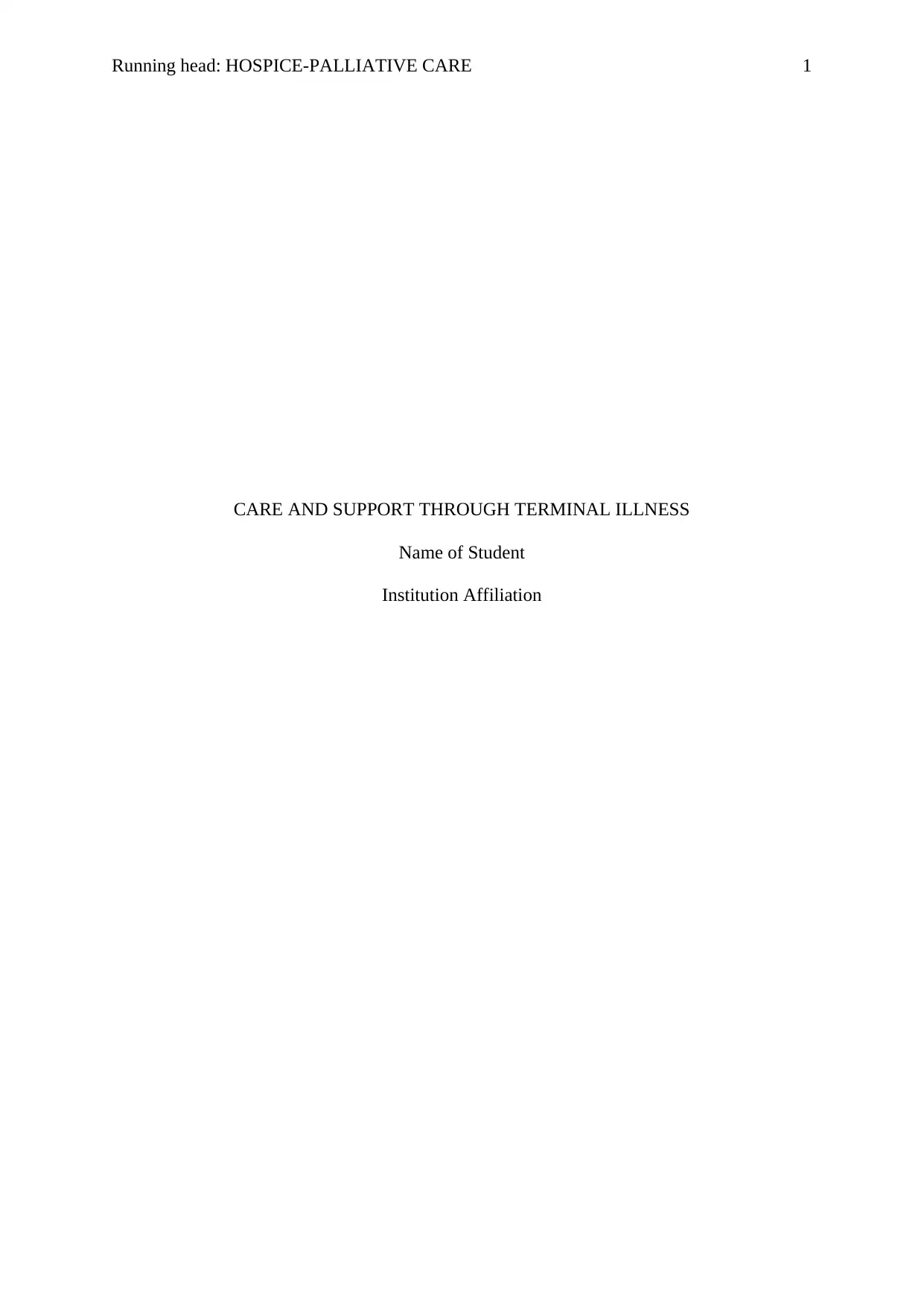
Running head: HOSPICE-PALLIATIVE CARE 1
CARE AND SUPPORT THROUGH TERMINAL ILLNESS
Name of Student
Institution Affiliation
CARE AND SUPPORT THROUGH TERMINAL ILLNESS
Name of Student
Institution Affiliation
Paraphrase This Document
Need a fresh take? Get an instant paraphrase of this document with our AI Paraphraser
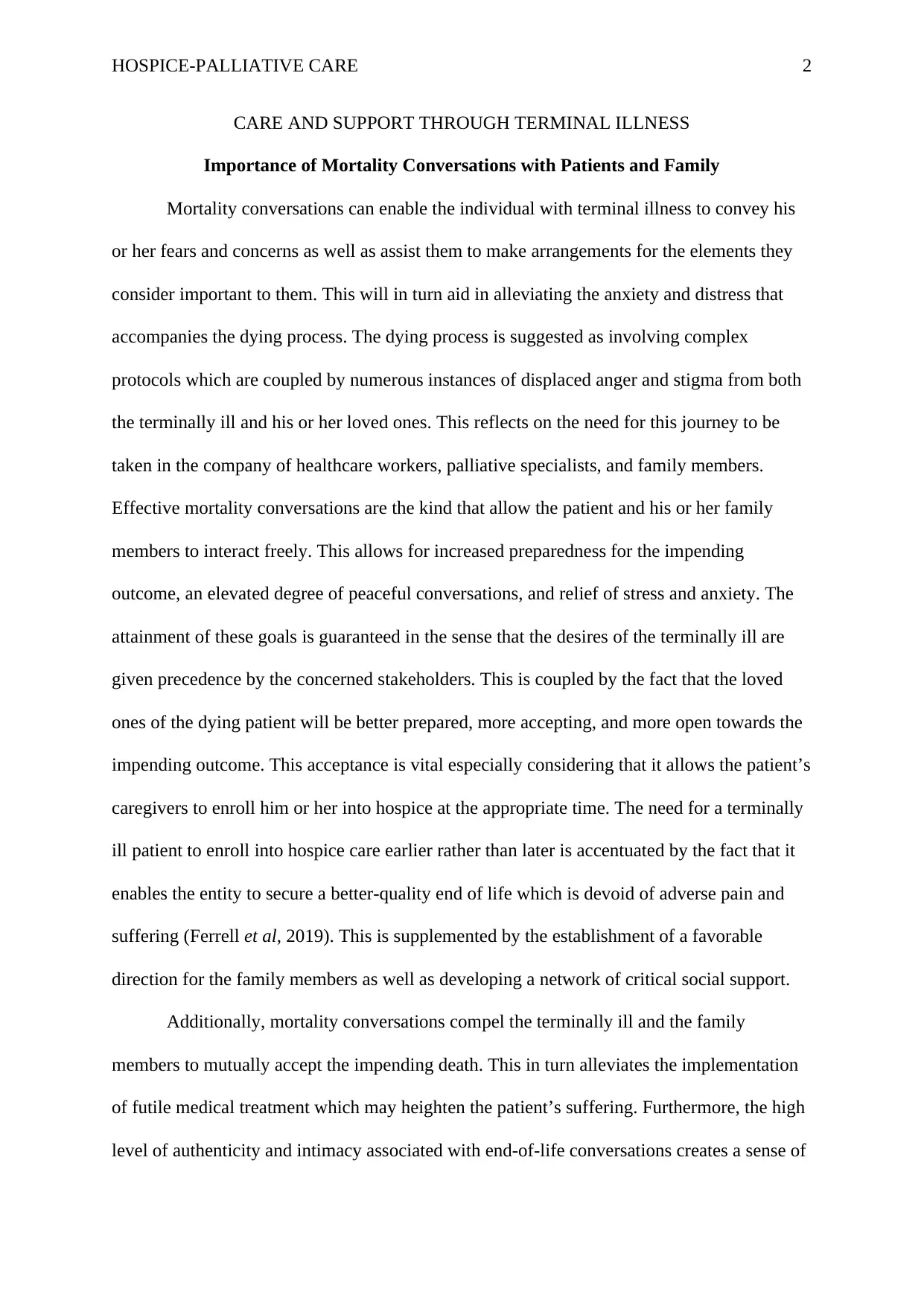
HOSPICE-PALLIATIVE CARE 2
CARE AND SUPPORT THROUGH TERMINAL ILLNESS
Importance of Mortality Conversations with Patients and Family
Mortality conversations can enable the individual with terminal illness to convey his
or her fears and concerns as well as assist them to make arrangements for the elements they
consider important to them. This will in turn aid in alleviating the anxiety and distress that
accompanies the dying process. The dying process is suggested as involving complex
protocols which are coupled by numerous instances of displaced anger and stigma from both
the terminally ill and his or her loved ones. This reflects on the need for this journey to be
taken in the company of healthcare workers, palliative specialists, and family members.
Effective mortality conversations are the kind that allow the patient and his or her family
members to interact freely. This allows for increased preparedness for the impending
outcome, an elevated degree of peaceful conversations, and relief of stress and anxiety. The
attainment of these goals is guaranteed in the sense that the desires of the terminally ill are
given precedence by the concerned stakeholders. This is coupled by the fact that the loved
ones of the dying patient will be better prepared, more accepting, and more open towards the
impending outcome. This acceptance is vital especially considering that it allows the patient’s
caregivers to enroll him or her into hospice at the appropriate time. The need for a terminally
ill patient to enroll into hospice care earlier rather than later is accentuated by the fact that it
enables the entity to secure a better-quality end of life which is devoid of adverse pain and
suffering (Ferrell et al, 2019). This is supplemented by the establishment of a favorable
direction for the family members as well as developing a network of critical social support.
Additionally, mortality conversations compel the terminally ill and the family
members to mutually accept the impending death. This in turn alleviates the implementation
of futile medical treatment which may heighten the patient’s suffering. Furthermore, the high
level of authenticity and intimacy associated with end-of-life conversations creates a sense of
CARE AND SUPPORT THROUGH TERMINAL ILLNESS
Importance of Mortality Conversations with Patients and Family
Mortality conversations can enable the individual with terminal illness to convey his
or her fears and concerns as well as assist them to make arrangements for the elements they
consider important to them. This will in turn aid in alleviating the anxiety and distress that
accompanies the dying process. The dying process is suggested as involving complex
protocols which are coupled by numerous instances of displaced anger and stigma from both
the terminally ill and his or her loved ones. This reflects on the need for this journey to be
taken in the company of healthcare workers, palliative specialists, and family members.
Effective mortality conversations are the kind that allow the patient and his or her family
members to interact freely. This allows for increased preparedness for the impending
outcome, an elevated degree of peaceful conversations, and relief of stress and anxiety. The
attainment of these goals is guaranteed in the sense that the desires of the terminally ill are
given precedence by the concerned stakeholders. This is coupled by the fact that the loved
ones of the dying patient will be better prepared, more accepting, and more open towards the
impending outcome. This acceptance is vital especially considering that it allows the patient’s
caregivers to enroll him or her into hospice at the appropriate time. The need for a terminally
ill patient to enroll into hospice care earlier rather than later is accentuated by the fact that it
enables the entity to secure a better-quality end of life which is devoid of adverse pain and
suffering (Ferrell et al, 2019). This is supplemented by the establishment of a favorable
direction for the family members as well as developing a network of critical social support.
Additionally, mortality conversations compel the terminally ill and the family
members to mutually accept the impending death. This in turn alleviates the implementation
of futile medical treatment which may heighten the patient’s suffering. Furthermore, the high
level of authenticity and intimacy associated with end-of-life conversations creates a sense of
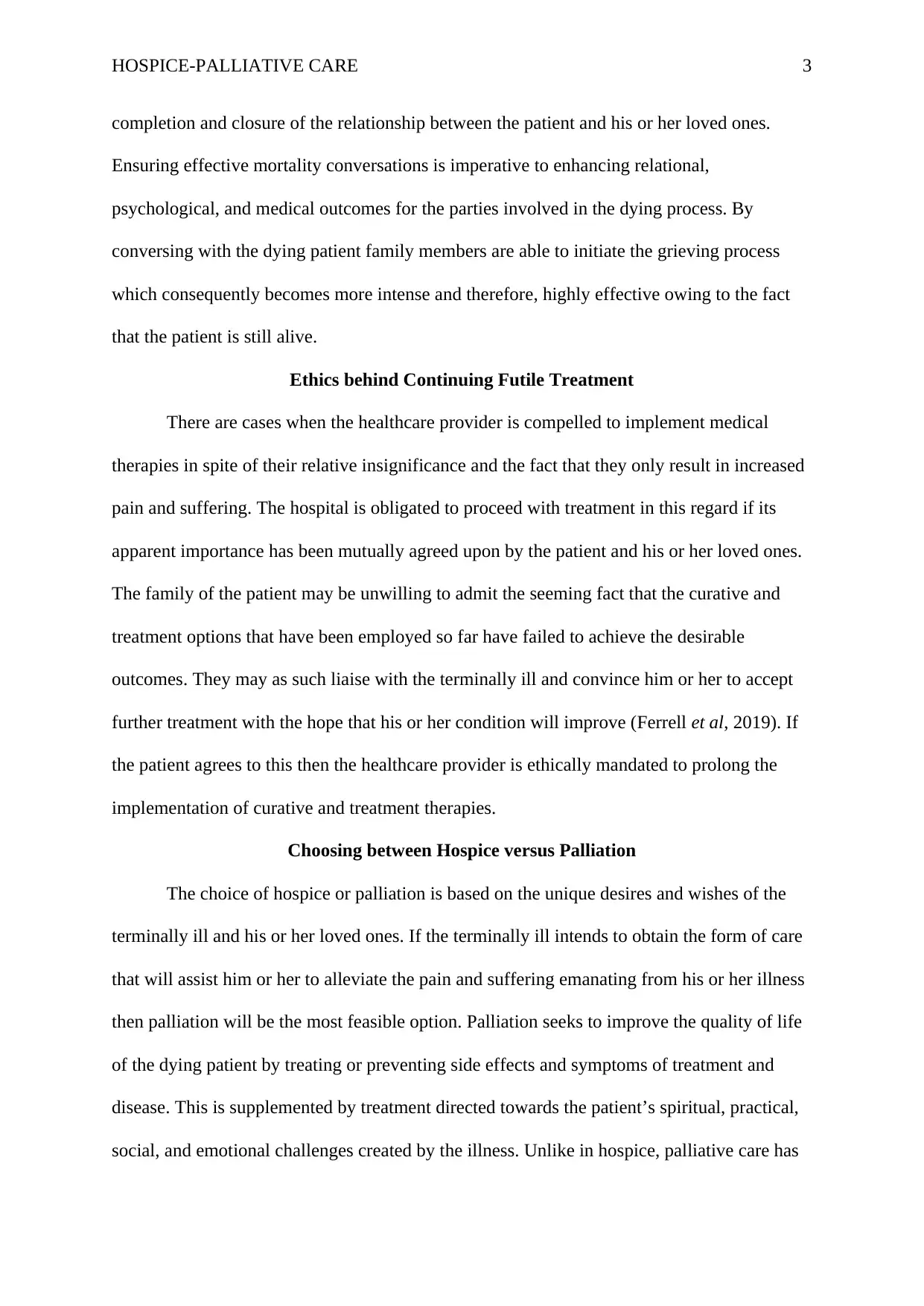
HOSPICE-PALLIATIVE CARE 3
completion and closure of the relationship between the patient and his or her loved ones.
Ensuring effective mortality conversations is imperative to enhancing relational,
psychological, and medical outcomes for the parties involved in the dying process. By
conversing with the dying patient family members are able to initiate the grieving process
which consequently becomes more intense and therefore, highly effective owing to the fact
that the patient is still alive.
Ethics behind Continuing Futile Treatment
There are cases when the healthcare provider is compelled to implement medical
therapies in spite of their relative insignificance and the fact that they only result in increased
pain and suffering. The hospital is obligated to proceed with treatment in this regard if its
apparent importance has been mutually agreed upon by the patient and his or her loved ones.
The family of the patient may be unwilling to admit the seeming fact that the curative and
treatment options that have been employed so far have failed to achieve the desirable
outcomes. They may as such liaise with the terminally ill and convince him or her to accept
further treatment with the hope that his or her condition will improve (Ferrell et al, 2019). If
the patient agrees to this then the healthcare provider is ethically mandated to prolong the
implementation of curative and treatment therapies.
Choosing between Hospice versus Palliation
The choice of hospice or palliation is based on the unique desires and wishes of the
terminally ill and his or her loved ones. If the terminally ill intends to obtain the form of care
that will assist him or her to alleviate the pain and suffering emanating from his or her illness
then palliation will be the most feasible option. Palliation seeks to improve the quality of life
of the dying patient by treating or preventing side effects and symptoms of treatment and
disease. This is supplemented by treatment directed towards the patient’s spiritual, practical,
social, and emotional challenges created by the illness. Unlike in hospice, palliative care has
completion and closure of the relationship between the patient and his or her loved ones.
Ensuring effective mortality conversations is imperative to enhancing relational,
psychological, and medical outcomes for the parties involved in the dying process. By
conversing with the dying patient family members are able to initiate the grieving process
which consequently becomes more intense and therefore, highly effective owing to the fact
that the patient is still alive.
Ethics behind Continuing Futile Treatment
There are cases when the healthcare provider is compelled to implement medical
therapies in spite of their relative insignificance and the fact that they only result in increased
pain and suffering. The hospital is obligated to proceed with treatment in this regard if its
apparent importance has been mutually agreed upon by the patient and his or her loved ones.
The family of the patient may be unwilling to admit the seeming fact that the curative and
treatment options that have been employed so far have failed to achieve the desirable
outcomes. They may as such liaise with the terminally ill and convince him or her to accept
further treatment with the hope that his or her condition will improve (Ferrell et al, 2019). If
the patient agrees to this then the healthcare provider is ethically mandated to prolong the
implementation of curative and treatment therapies.
Choosing between Hospice versus Palliation
The choice of hospice or palliation is based on the unique desires and wishes of the
terminally ill and his or her loved ones. If the terminally ill intends to obtain the form of care
that will assist him or her to alleviate the pain and suffering emanating from his or her illness
then palliation will be the most feasible option. Palliation seeks to improve the quality of life
of the dying patient by treating or preventing side effects and symptoms of treatment and
disease. This is supplemented by treatment directed towards the patient’s spiritual, practical,
social, and emotional challenges created by the illness. Unlike in hospice, palliative care has
⊘ This is a preview!⊘
Do you want full access?
Subscribe today to unlock all pages.

Trusted by 1+ million students worldwide
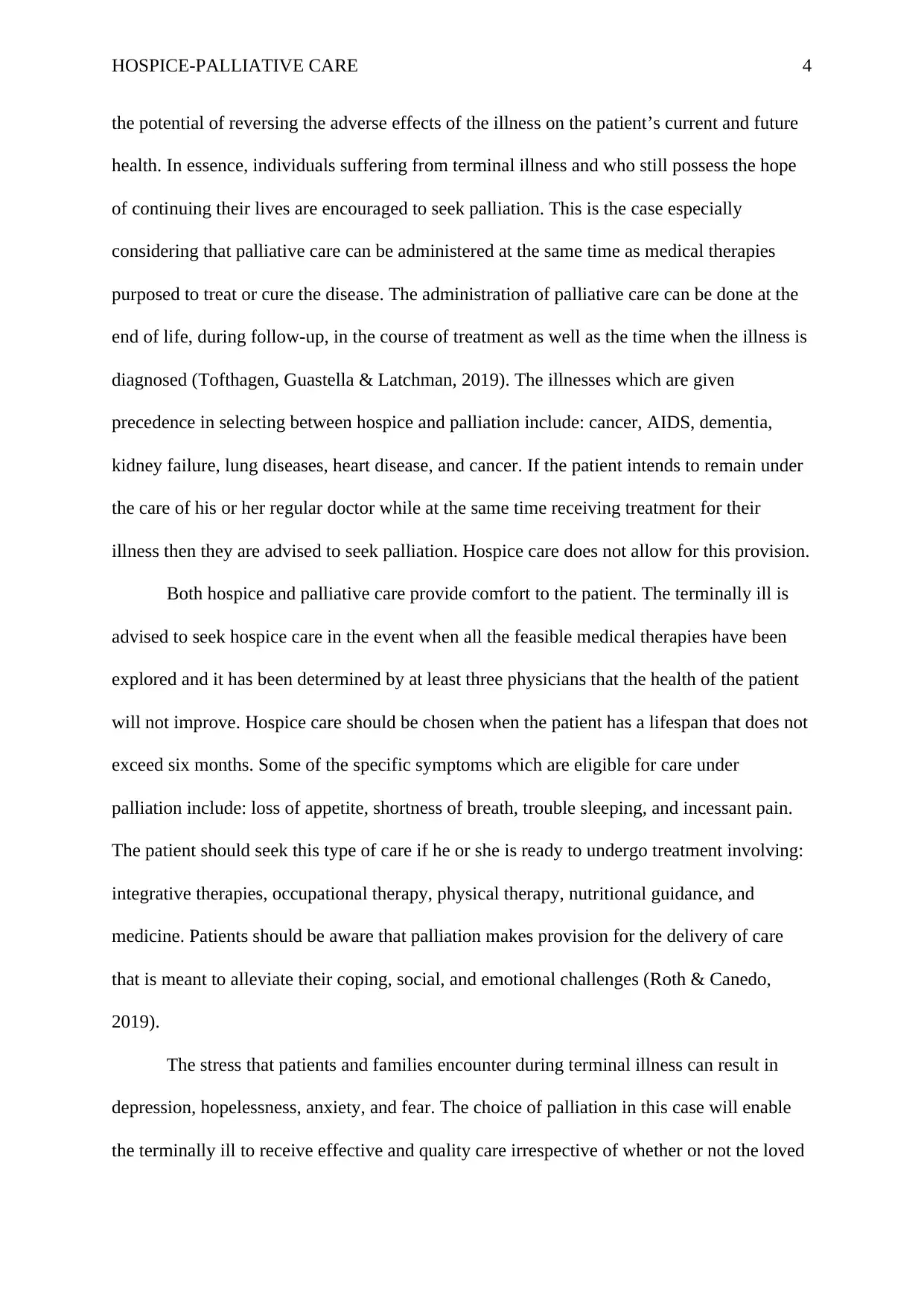
HOSPICE-PALLIATIVE CARE 4
the potential of reversing the adverse effects of the illness on the patient’s current and future
health. In essence, individuals suffering from terminal illness and who still possess the hope
of continuing their lives are encouraged to seek palliation. This is the case especially
considering that palliative care can be administered at the same time as medical therapies
purposed to treat or cure the disease. The administration of palliative care can be done at the
end of life, during follow-up, in the course of treatment as well as the time when the illness is
diagnosed (Tofthagen, Guastella & Latchman, 2019). The illnesses which are given
precedence in selecting between hospice and palliation include: cancer, AIDS, dementia,
kidney failure, lung diseases, heart disease, and cancer. If the patient intends to remain under
the care of his or her regular doctor while at the same time receiving treatment for their
illness then they are advised to seek palliation. Hospice care does not allow for this provision.
Both hospice and palliative care provide comfort to the patient. The terminally ill is
advised to seek hospice care in the event when all the feasible medical therapies have been
explored and it has been determined by at least three physicians that the health of the patient
will not improve. Hospice care should be chosen when the patient has a lifespan that does not
exceed six months. Some of the specific symptoms which are eligible for care under
palliation include: loss of appetite, shortness of breath, trouble sleeping, and incessant pain.
The patient should seek this type of care if he or she is ready to undergo treatment involving:
integrative therapies, occupational therapy, physical therapy, nutritional guidance, and
medicine. Patients should be aware that palliation makes provision for the delivery of care
that is meant to alleviate their coping, social, and emotional challenges (Roth & Canedo,
2019).
The stress that patients and families encounter during terminal illness can result in
depression, hopelessness, anxiety, and fear. The choice of palliation in this case will enable
the terminally ill to receive effective and quality care irrespective of whether or not the loved
the potential of reversing the adverse effects of the illness on the patient’s current and future
health. In essence, individuals suffering from terminal illness and who still possess the hope
of continuing their lives are encouraged to seek palliation. This is the case especially
considering that palliative care can be administered at the same time as medical therapies
purposed to treat or cure the disease. The administration of palliative care can be done at the
end of life, during follow-up, in the course of treatment as well as the time when the illness is
diagnosed (Tofthagen, Guastella & Latchman, 2019). The illnesses which are given
precedence in selecting between hospice and palliation include: cancer, AIDS, dementia,
kidney failure, lung diseases, heart disease, and cancer. If the patient intends to remain under
the care of his or her regular doctor while at the same time receiving treatment for their
illness then they are advised to seek palliation. Hospice care does not allow for this provision.
Both hospice and palliative care provide comfort to the patient. The terminally ill is
advised to seek hospice care in the event when all the feasible medical therapies have been
explored and it has been determined by at least three physicians that the health of the patient
will not improve. Hospice care should be chosen when the patient has a lifespan that does not
exceed six months. Some of the specific symptoms which are eligible for care under
palliation include: loss of appetite, shortness of breath, trouble sleeping, and incessant pain.
The patient should seek this type of care if he or she is ready to undergo treatment involving:
integrative therapies, occupational therapy, physical therapy, nutritional guidance, and
medicine. Patients should be aware that palliation makes provision for the delivery of care
that is meant to alleviate their coping, social, and emotional challenges (Roth & Canedo,
2019).
The stress that patients and families encounter during terminal illness can result in
depression, hopelessness, anxiety, and fear. The choice of palliation in this case will enable
the terminally ill to receive effective and quality care irrespective of whether or not the loved
Paraphrase This Document
Need a fresh take? Get an instant paraphrase of this document with our AI Paraphraser
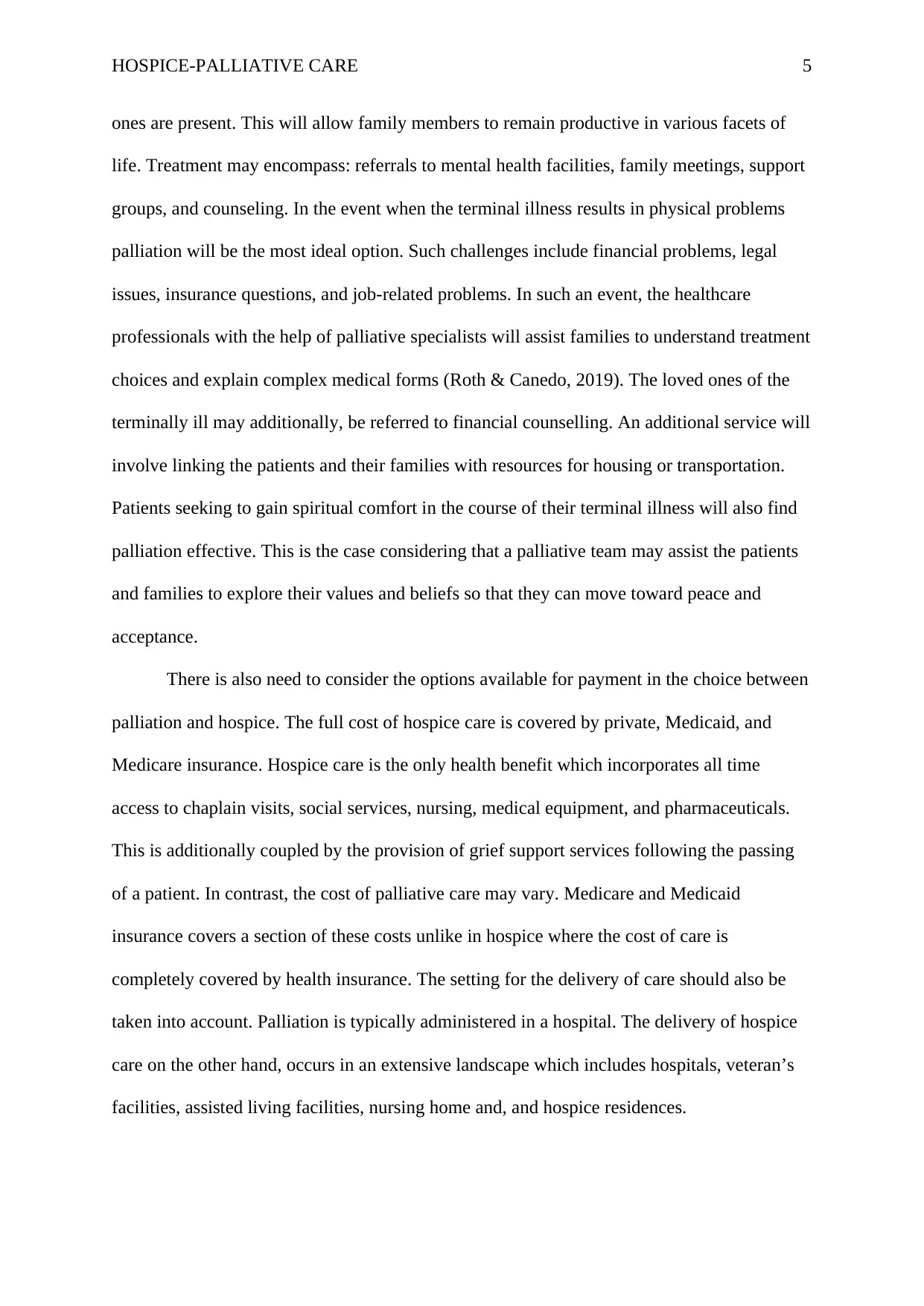
HOSPICE-PALLIATIVE CARE 5
ones are present. This will allow family members to remain productive in various facets of
life. Treatment may encompass: referrals to mental health facilities, family meetings, support
groups, and counseling. In the event when the terminal illness results in physical problems
palliation will be the most ideal option. Such challenges include financial problems, legal
issues, insurance questions, and job-related problems. In such an event, the healthcare
professionals with the help of palliative specialists will assist families to understand treatment
choices and explain complex medical forms (Roth & Canedo, 2019). The loved ones of the
terminally ill may additionally, be referred to financial counselling. An additional service will
involve linking the patients and their families with resources for housing or transportation.
Patients seeking to gain spiritual comfort in the course of their terminal illness will also find
palliation effective. This is the case considering that a palliative team may assist the patients
and families to explore their values and beliefs so that they can move toward peace and
acceptance.
There is also need to consider the options available for payment in the choice between
palliation and hospice. The full cost of hospice care is covered by private, Medicaid, and
Medicare insurance. Hospice care is the only health benefit which incorporates all time
access to chaplain visits, social services, nursing, medical equipment, and pharmaceuticals.
This is additionally coupled by the provision of grief support services following the passing
of a patient. In contrast, the cost of palliative care may vary. Medicare and Medicaid
insurance covers a section of these costs unlike in hospice where the cost of care is
completely covered by health insurance. The setting for the delivery of care should also be
taken into account. Palliation is typically administered in a hospital. The delivery of hospice
care on the other hand, occurs in an extensive landscape which includes hospitals, veteran’s
facilities, assisted living facilities, nursing home and, and hospice residences.
ones are present. This will allow family members to remain productive in various facets of
life. Treatment may encompass: referrals to mental health facilities, family meetings, support
groups, and counseling. In the event when the terminal illness results in physical problems
palliation will be the most ideal option. Such challenges include financial problems, legal
issues, insurance questions, and job-related problems. In such an event, the healthcare
professionals with the help of palliative specialists will assist families to understand treatment
choices and explain complex medical forms (Roth & Canedo, 2019). The loved ones of the
terminally ill may additionally, be referred to financial counselling. An additional service will
involve linking the patients and their families with resources for housing or transportation.
Patients seeking to gain spiritual comfort in the course of their terminal illness will also find
palliation effective. This is the case considering that a palliative team may assist the patients
and families to explore their values and beliefs so that they can move toward peace and
acceptance.
There is also need to consider the options available for payment in the choice between
palliation and hospice. The full cost of hospice care is covered by private, Medicaid, and
Medicare insurance. Hospice care is the only health benefit which incorporates all time
access to chaplain visits, social services, nursing, medical equipment, and pharmaceuticals.
This is additionally coupled by the provision of grief support services following the passing
of a patient. In contrast, the cost of palliative care may vary. Medicare and Medicaid
insurance covers a section of these costs unlike in hospice where the cost of care is
completely covered by health insurance. The setting for the delivery of care should also be
taken into account. Palliation is typically administered in a hospital. The delivery of hospice
care on the other hand, occurs in an extensive landscape which includes hospitals, veteran’s
facilities, assisted living facilities, nursing home and, and hospice residences.
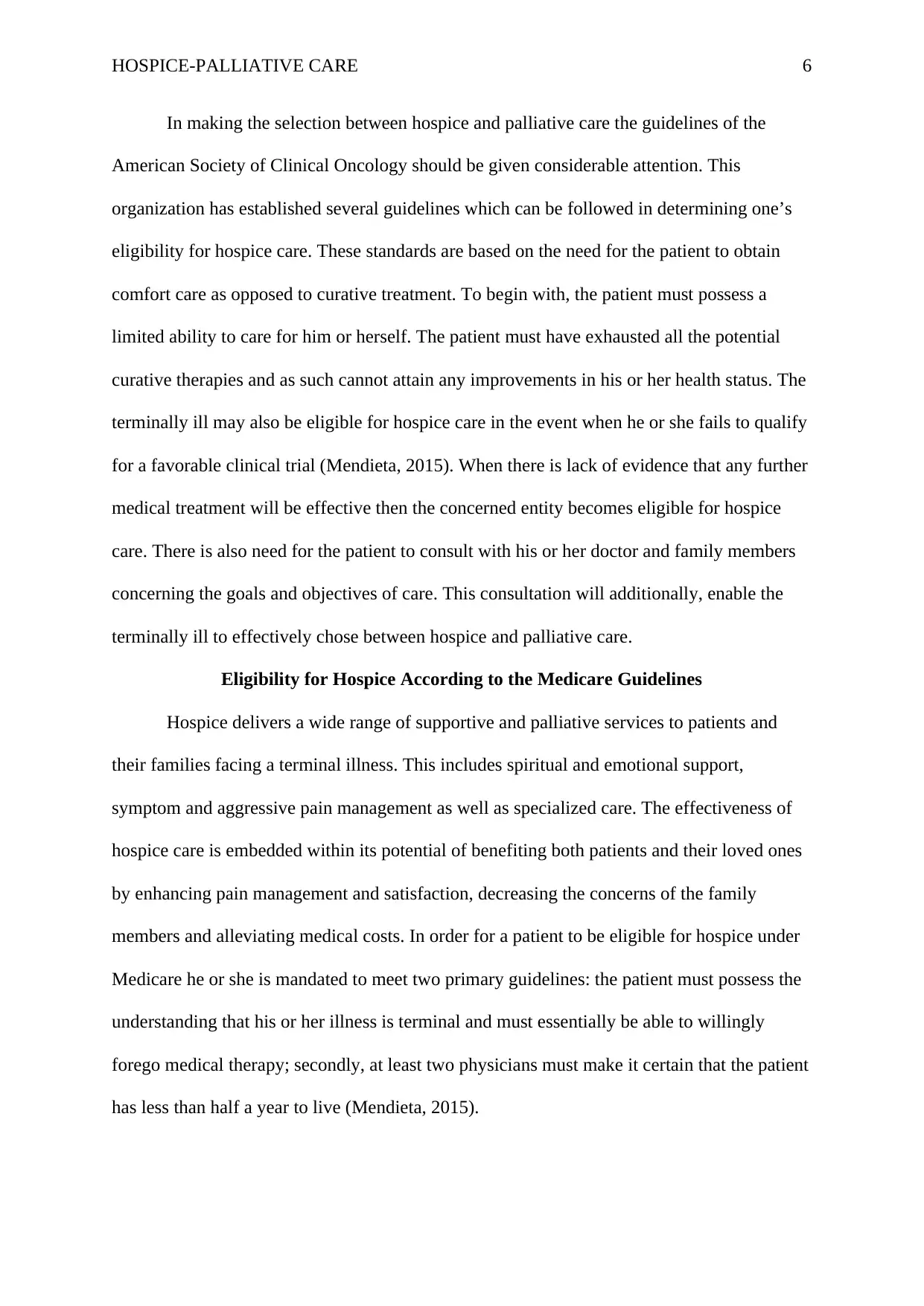
HOSPICE-PALLIATIVE CARE 6
In making the selection between hospice and palliative care the guidelines of the
American Society of Clinical Oncology should be given considerable attention. This
organization has established several guidelines which can be followed in determining one’s
eligibility for hospice care. These standards are based on the need for the patient to obtain
comfort care as opposed to curative treatment. To begin with, the patient must possess a
limited ability to care for him or herself. The patient must have exhausted all the potential
curative therapies and as such cannot attain any improvements in his or her health status. The
terminally ill may also be eligible for hospice care in the event when he or she fails to qualify
for a favorable clinical trial (Mendieta, 2015). When there is lack of evidence that any further
medical treatment will be effective then the concerned entity becomes eligible for hospice
care. There is also need for the patient to consult with his or her doctor and family members
concerning the goals and objectives of care. This consultation will additionally, enable the
terminally ill to effectively chose between hospice and palliative care.
Eligibility for Hospice According to the Medicare Guidelines
Hospice delivers a wide range of supportive and palliative services to patients and
their families facing a terminal illness. This includes spiritual and emotional support,
symptom and aggressive pain management as well as specialized care. The effectiveness of
hospice care is embedded within its potential of benefiting both patients and their loved ones
by enhancing pain management and satisfaction, decreasing the concerns of the family
members and alleviating medical costs. In order for a patient to be eligible for hospice under
Medicare he or she is mandated to meet two primary guidelines: the patient must possess the
understanding that his or her illness is terminal and must essentially be able to willingly
forego medical therapy; secondly, at least two physicians must make it certain that the patient
has less than half a year to live (Mendieta, 2015).
In making the selection between hospice and palliative care the guidelines of the
American Society of Clinical Oncology should be given considerable attention. This
organization has established several guidelines which can be followed in determining one’s
eligibility for hospice care. These standards are based on the need for the patient to obtain
comfort care as opposed to curative treatment. To begin with, the patient must possess a
limited ability to care for him or herself. The patient must have exhausted all the potential
curative therapies and as such cannot attain any improvements in his or her health status. The
terminally ill may also be eligible for hospice care in the event when he or she fails to qualify
for a favorable clinical trial (Mendieta, 2015). When there is lack of evidence that any further
medical treatment will be effective then the concerned entity becomes eligible for hospice
care. There is also need for the patient to consult with his or her doctor and family members
concerning the goals and objectives of care. This consultation will additionally, enable the
terminally ill to effectively chose between hospice and palliative care.
Eligibility for Hospice According to the Medicare Guidelines
Hospice delivers a wide range of supportive and palliative services to patients and
their families facing a terminal illness. This includes spiritual and emotional support,
symptom and aggressive pain management as well as specialized care. The effectiveness of
hospice care is embedded within its potential of benefiting both patients and their loved ones
by enhancing pain management and satisfaction, decreasing the concerns of the family
members and alleviating medical costs. In order for a patient to be eligible for hospice under
Medicare he or she is mandated to meet two primary guidelines: the patient must possess the
understanding that his or her illness is terminal and must essentially be able to willingly
forego medical therapy; secondly, at least two physicians must make it certain that the patient
has less than half a year to live (Mendieta, 2015).
⊘ This is a preview!⊘
Do you want full access?
Subscribe today to unlock all pages.

Trusted by 1+ million students worldwide
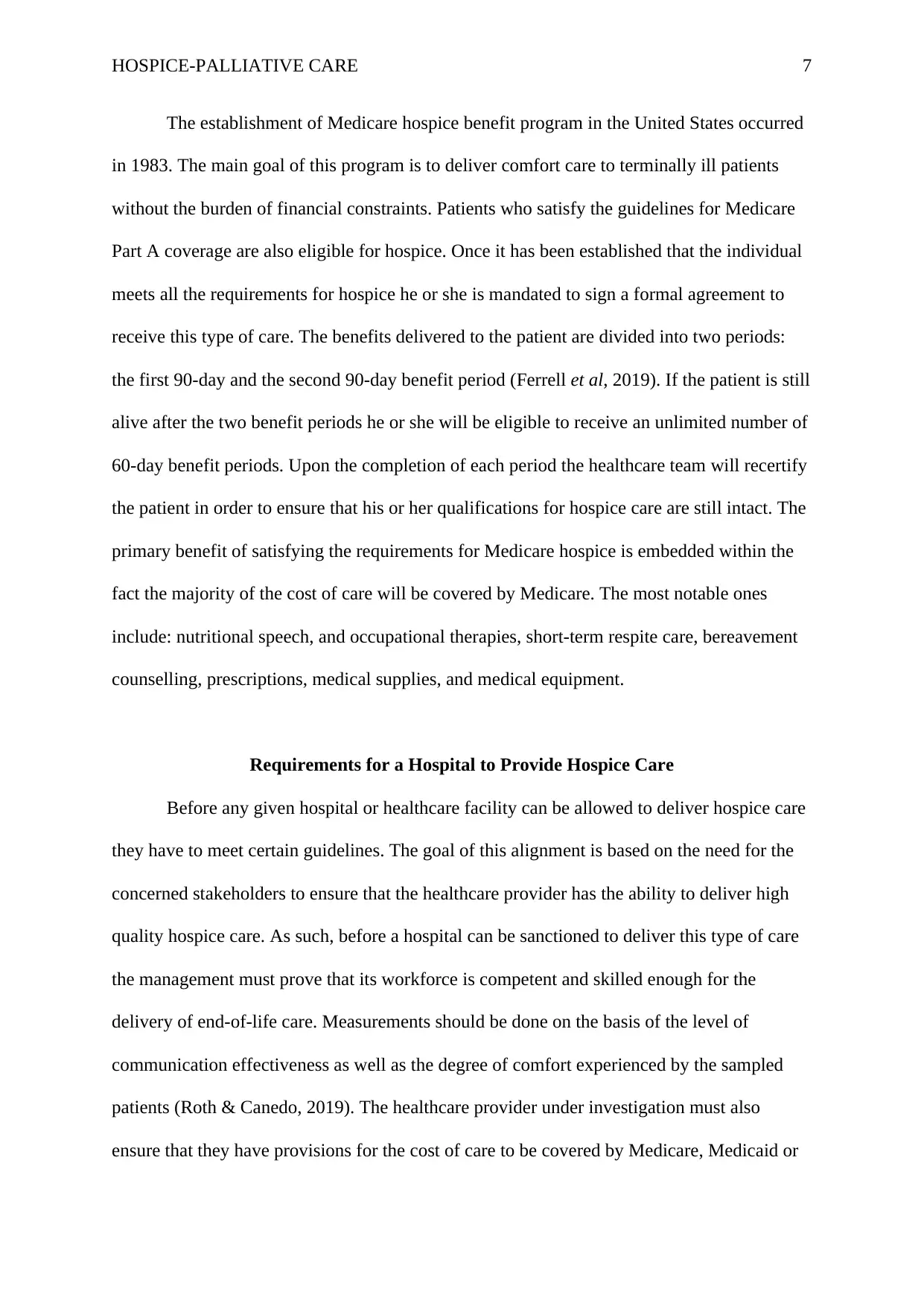
HOSPICE-PALLIATIVE CARE 7
The establishment of Medicare hospice benefit program in the United States occurred
in 1983. The main goal of this program is to deliver comfort care to terminally ill patients
without the burden of financial constraints. Patients who satisfy the guidelines for Medicare
Part A coverage are also eligible for hospice. Once it has been established that the individual
meets all the requirements for hospice he or she is mandated to sign a formal agreement to
receive this type of care. The benefits delivered to the patient are divided into two periods:
the first 90-day and the second 90-day benefit period (Ferrell et al, 2019). If the patient is still
alive after the two benefit periods he or she will be eligible to receive an unlimited number of
60-day benefit periods. Upon the completion of each period the healthcare team will recertify
the patient in order to ensure that his or her qualifications for hospice care are still intact. The
primary benefit of satisfying the requirements for Medicare hospice is embedded within the
fact the majority of the cost of care will be covered by Medicare. The most notable ones
include: nutritional speech, and occupational therapies, short-term respite care, bereavement
counselling, prescriptions, medical supplies, and medical equipment.
Requirements for a Hospital to Provide Hospice Care
Before any given hospital or healthcare facility can be allowed to deliver hospice care
they have to meet certain guidelines. The goal of this alignment is based on the need for the
concerned stakeholders to ensure that the healthcare provider has the ability to deliver high
quality hospice care. As such, before a hospital can be sanctioned to deliver this type of care
the management must prove that its workforce is competent and skilled enough for the
delivery of end-of-life care. Measurements should be done on the basis of the level of
communication effectiveness as well as the degree of comfort experienced by the sampled
patients (Roth & Canedo, 2019). The healthcare provider under investigation must also
ensure that they have provisions for the cost of care to be covered by Medicare, Medicaid or
The establishment of Medicare hospice benefit program in the United States occurred
in 1983. The main goal of this program is to deliver comfort care to terminally ill patients
without the burden of financial constraints. Patients who satisfy the guidelines for Medicare
Part A coverage are also eligible for hospice. Once it has been established that the individual
meets all the requirements for hospice he or she is mandated to sign a formal agreement to
receive this type of care. The benefits delivered to the patient are divided into two periods:
the first 90-day and the second 90-day benefit period (Ferrell et al, 2019). If the patient is still
alive after the two benefit periods he or she will be eligible to receive an unlimited number of
60-day benefit periods. Upon the completion of each period the healthcare team will recertify
the patient in order to ensure that his or her qualifications for hospice care are still intact. The
primary benefit of satisfying the requirements for Medicare hospice is embedded within the
fact the majority of the cost of care will be covered by Medicare. The most notable ones
include: nutritional speech, and occupational therapies, short-term respite care, bereavement
counselling, prescriptions, medical supplies, and medical equipment.
Requirements for a Hospital to Provide Hospice Care
Before any given hospital or healthcare facility can be allowed to deliver hospice care
they have to meet certain guidelines. The goal of this alignment is based on the need for the
concerned stakeholders to ensure that the healthcare provider has the ability to deliver high
quality hospice care. As such, before a hospital can be sanctioned to deliver this type of care
the management must prove that its workforce is competent and skilled enough for the
delivery of end-of-life care. Measurements should be done on the basis of the level of
communication effectiveness as well as the degree of comfort experienced by the sampled
patients (Roth & Canedo, 2019). The healthcare provider under investigation must also
ensure that they have provisions for the cost of care to be covered by Medicare, Medicaid or
Paraphrase This Document
Need a fresh take? Get an instant paraphrase of this document with our AI Paraphraser

HOSPICE-PALLIATIVE CARE 8
private insurance. The hospital must additionally, possess the appropriate number of hospice
specialist and social workers who will work in collaboration with healthcare professionals
and the loved ones of the patient in delivering hospice care.
private insurance. The hospital must additionally, possess the appropriate number of hospice
specialist and social workers who will work in collaboration with healthcare professionals
and the loved ones of the patient in delivering hospice care.
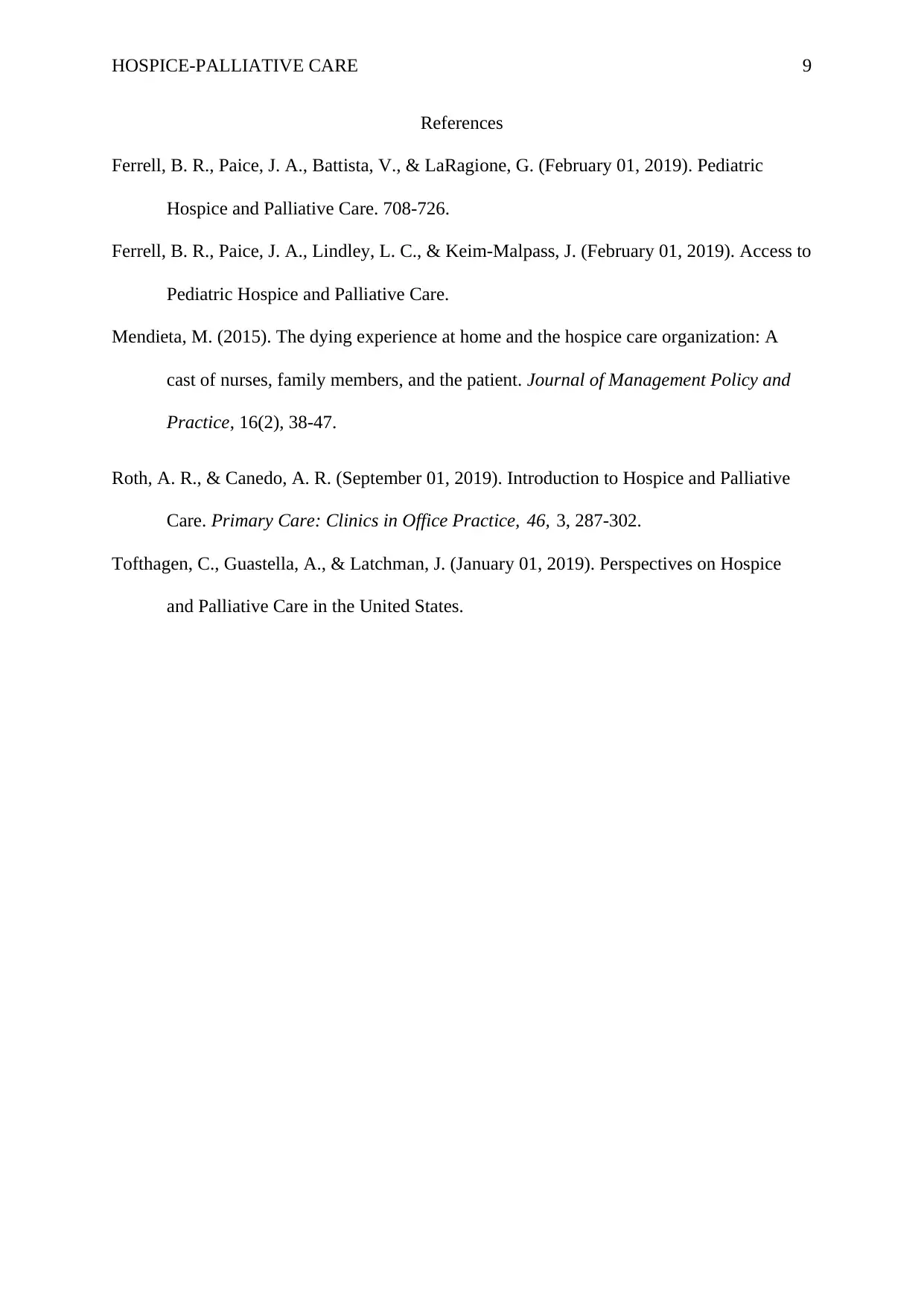
HOSPICE-PALLIATIVE CARE 9
References
Ferrell, B. R., Paice, J. A., Battista, V., & LaRagione, G. (February 01, 2019). Pediatric
Hospice and Palliative Care. 708-726.
Ferrell, B. R., Paice, J. A., Lindley, L. C., & Keim-Malpass, J. (February 01, 2019). Access to
Pediatric Hospice and Palliative Care.
Mendieta, M. (2015). The dying experience at home and the hospice care organization: A
cast of nurses, family members, and the patient. Journal of Management Policy and
Practice, 16(2), 38-47.
Roth, A. R., & Canedo, A. R. (September 01, 2019). Introduction to Hospice and Palliative
Care. Primary Care: Clinics in Office Practice, 46, 3, 287-302.
Tofthagen, C., Guastella, A., & Latchman, J. (January 01, 2019). Perspectives on Hospice
and Palliative Care in the United States.
References
Ferrell, B. R., Paice, J. A., Battista, V., & LaRagione, G. (February 01, 2019). Pediatric
Hospice and Palliative Care. 708-726.
Ferrell, B. R., Paice, J. A., Lindley, L. C., & Keim-Malpass, J. (February 01, 2019). Access to
Pediatric Hospice and Palliative Care.
Mendieta, M. (2015). The dying experience at home and the hospice care organization: A
cast of nurses, family members, and the patient. Journal of Management Policy and
Practice, 16(2), 38-47.
Roth, A. R., & Canedo, A. R. (September 01, 2019). Introduction to Hospice and Palliative
Care. Primary Care: Clinics in Office Practice, 46, 3, 287-302.
Tofthagen, C., Guastella, A., & Latchman, J. (January 01, 2019). Perspectives on Hospice
and Palliative Care in the United States.
⊘ This is a preview!⊘
Do you want full access?
Subscribe today to unlock all pages.

Trusted by 1+ million students worldwide
1 out of 9
Related Documents
Your All-in-One AI-Powered Toolkit for Academic Success.
+13062052269
info@desklib.com
Available 24*7 on WhatsApp / Email
![[object Object]](/_next/static/media/star-bottom.7253800d.svg)
Unlock your academic potential
Copyright © 2020–2025 A2Z Services. All Rights Reserved. Developed and managed by ZUCOL.





